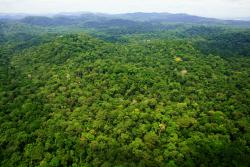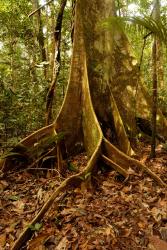Tropical forestsт carbon sink is already rapidly weakening
Mae Dr Simon Willcock, Uwch Ddarlithydd mewn Daearyddiaeth Amgylcheddol yn Ysgol Gwyddorau Naturiol Prifysgol Bangor yn arbenigwr mewn tirweddau trofannol aтr buddion y mae pobl yn eu cael ohonynt. Cyfrannodd at ddarn mawr o ymchwil, a gyhoeddwyd heddiw. Buтn casglu a darparu data o fforestydd glaw Tanzania, ynghyd УЂ chydweithio УЂ pharatoiтr papur.
Meddai: тMae coedwigoedd trofannol y byd yn hynod bwysig ac felly mae'r canfyddiadau hyn yn frawychus. Er mwyn deall effaith ein planed newidiol, daeth gwyddonwyr o bron i 100 o sefydliadau ynghyd i rannu gwybodaeth a chydweithio. Os ydym am ddatrys problemau byd-eang fel newid yn yr hinsawdd, mae angen i wleidyddion, y rhai sy'n gwneud penderfyniadau, ac aelodau'r cyhoedd wneud yr un peth - i gydweithio tuag at yr un gУДl. т
 Above Ivindo National Park, central Gabon. : Credit. Kath Jeffery
Above Ivindo National Park, central Gabon. : Credit. Kath Jeffery
Datganiad i'r wasg gan Brifysgol Leeds / Royal Museum for Central Africa:
The ability of the worldтs tropical forests to remove carbon from the atmosphere is decreasing, according to a study tracking 300,000 trees over 30 years, published today in Nature.
The global scientific collaboration, led by the University of Leeds, reveals that a feared switch of the worldтs undisturbed tropical forests from a carbon sink to a carbon source has begun.
I Amazon Forest canopy at Dawn Brazil : _Peter Vander Sleenntact tropical forests are well-known as a crucial global carbon sink, slowing climate change by removing carbon from the atmosphere and storing it in trees, a process known as carbon sequestration. Climate models typically predict that this tropical forest carbon sink will continue for decades.
Amazon Forest canopy at Dawn Brazil : _Peter Vander Sleenntact tropical forests are well-known as a crucial global carbon sink, slowing climate change by removing carbon from the atmosphere and storing it in trees, a process known as carbon sequestration. Climate models typically predict that this tropical forest carbon sink will continue for decades.
However, the new analysis of three decades of tree growth and death from 565 undisturbed tropical forests across Africa and the Amazon has found that the overall uptake of carbon into Earthтs intact tropical forests peaked in the 1990s.
By the 2010s, on average, the ability of a tropical forest to absorb carbon had dropped by one-third. The switch is largely driven by carbon losses from trees dying.
The study by almost 100 institutions provides the first large-scale evidence that carbon uptake by the worldтs tropical forests has already started a worrying downward trend.
ТщЖЙДЋУНИпЧхАц lead author Dr Wannes Hubau, a former post-doctoral researcher at the University of Leeds now based at the Royal Museum for Central Africa in Belgium, said: тWe show that peak carbon uptake into intact tropical forests occurred in the 1990s.
тBy combining data from Africa and the Amazon we began to understand why these forests are changing, with carbon dioxide levels, temperature, drought, and forest dynamics being key.т
 Tropical forests in Colombia: Credit: Peter VitzumтExtra carbon dioxide boosts tree growth, but every year this effect is being increasingly countered by the negative impacts of higher temperatures and droughts which slow growth and can kill trees.
Tropical forests in Colombia: Credit: Peter VitzumтExtra carbon dioxide boosts tree growth, but every year this effect is being increasingly countered by the negative impacts of higher temperatures and droughts which slow growth and can kill trees.
тOur modelling of these factors shows a long-term future decline in the African sink and that the Amazonian sink will continue to rapidly weaken, which we predict to become a carbon source in the mid-2030s.т
In the 1990s intact tropical forests removed roughly 46 billion tonnes of carbon dioxide from the atmosphere, declining to an estimated 25 billion tonnes in the 2010s.
The lost sink capacity in the 2010s compared to the 1990s is 21 billion tonnes carbon dioxide, equivalent to a decade of fossil fuel emissions from the UK, Germany, France and Canada combined.
Overall, intact tropical forests removed 17% of human-made carbon dioxide emissions in the 1990s, reduced to just 6% in the 2010s.
This decline is because these forests were less able to absorb carbon by 33% and the area of intact forest declined by 19%, while global carbon dioxide emissions soared by 46%.
Senior author Professor Simon Lewis, from the School of Geography at Leeds, said: тIntact tropical forests remain a vital carbon sink but this research reveals that unless policies are put in place to stabilise Earthтs climate it is only a matter of time until they are no longer able to sequester carbon.
тOne big concern for the future of humanity is when carbon-cycle feedbacks really kick in, with nature switching from slowing climate change to accelerating it.
тAfter years of work deep in the Congo and Amazon rainforests weтve found that one of the most worrying impacts of climate change has already begun. This is decades ahead of even the most pessimistic climate models.
тThere is no time to lose in terms of tackling climate change.т
To calculate changes in carbon storage the scientists measured the diameter and estimated the height of every individual tree in 565 patches of forest, returning every few years to re-measure them. By calculating the carbon stored in the trees that survived and those that died, the researchers tracked the changes in carbon storage over time.
After the final re-measurement, the study authors used a statistical model and trends in carbon dioxide emissions, temperature and rainfall to estimate changes in forest carbon storage until 2040.
By combining data from two large research networks of forests observations across Africa () and Amazonia () the authors show that the Amazon sink began weakening first, starting in the mid-1990s, followed by a waning of the African sink about 15 years later.
The continental difference arises from a combination of Amazon forests being more dynamic than those in Africa, and Amazon forests facing stronger climate impacts. Typical Amazonian forests are exposed to higher temperatures, faster temperature increases and more regular and severe droughts, than African forests.
Dr Hubau, Professor Lewis and their colleagues have spent years travelling to numerous remote field sites, including spending a week in a dug-out canoe to reach Salonga National Park in central Democratic Republic of Congo.
Dr Hubau said: тThe ability of forests to slow climate change is a crucial element of understanding how the Earth system functions т particularly how much carbon is absorbed by the Earth and how much is released into the atmosphere.
тContinued on-the-ground monitoring of intact tropical forests is required to track the effects of accelerating environmental change. We need this more than ever, as our planetтs last great tropical forests are threatened as never before.т
The authors also highlight that tropical forests are still huge reservoirs of carbon, storing 250 billion tonnes of carbon in their trees alone. This storage is equivalent to 90 years of global fossil fuel emissions at todayтs level.
ТщЖЙДЋУНИпЧхАц author Professor Bonaventure SonkУЉ from the University of Yaounde I in Cameroon said: тThe speed and magnitude of change in these forests suggests that climate impacts in the tropics may become more severe than predicted.
тAfrican countries and the international community will need to seriously invest in preparation for ongoing climate change impacts in tropical regions.т
ТщЖЙДЋУНИпЧхАц author Professor Oliver Phillips, from University of Leeds, added тFor too long the skills and potential of African and Amazonian scientists have been undervalued. We need to change this by ensuring their work is properly supported. It will fall to the next generation of African and Amazonian scientists to monitor these remarkable forests to help manage and protect themт.
As tropical forests are likely to sequester less carbon than predicted, carbon budgets and emissions targets may need reassessing to account for this.
Professor Lewis said: тThe immediate threats to tropical forests are deforestation, logging and fires. These require urgent action.
тIn addition, stabilising Earthтs climate is necessary to stabilise the carbon balance of intact tropical forests. By driving carbon dioxide emissions to net-zero even faster than currently envisaged, it would be possible to avoid intact tropical forests becoming a large source of carbon to the atmosphere. But that window of possibility is closing fast.т
Dyddiad cyhoeddi: 4 Mawrth 2020
